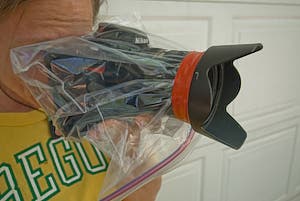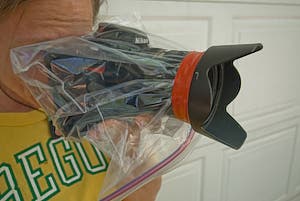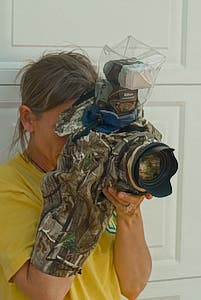Backcountry Photography, Part III of a Series




O.K., I finally reduced the shoulder dislocation from patting ourselves on the back over our NATIONAL MAGAZINE AWARDS (yahoo!). Now I can type again, and the subject is how to keep cameras alive in the woods while still having fun in extreme environments, which is, after all, where the cool pics are.
First off: People worry too much about their camera gear; Cameras are tougher than we think; probably tougher than ourselves. Ever since I got my first SLR, a classic, simple, entirely manual Pentax Spotmatic II in 1972 for high school graduation, I’ve been trying to kill cameras and have had only three failures. I once physically bent the lens and lens mount on a camera by dropping it onto boulders. The other two incidents were the same camera, a fancy medium format Pentax that shot gorgeous, dollar-bill-sized transparencies but was just plain lame otherwise. All the real cameras I’ve used and tested, none of them have ever died in normal, hard use, even in rain, humidity and subzero cold.
I can’t say the same for video gear,especially tape-based camcorders. The problem is usually humidity. When Backpacker began the Trailside and Anyplace Wild TV series back in the 90’s, dragging broadcast-quality TV gear into real boonies, I spent quite a few evenings holding camcorders over Coleman lanterns, gently baking them dry. The short version: It works, even if you scorch the plastic (not advisable). Again, tougher than we think, and memory-card based camcorders are already much tougher than that.
So when a camera body gets scratched, or a zoom lens gets grit in it, the look or feel may drive you nuts but usually you can’t see it in the photos and the camera will keep working just fine. Most of the time, with a little cleaning, wiping, and battery warming, your camera will breeze through truly miserable weather. But gear beaters can kill anything if they try, so here are some field tips to help keep you clicking away.
General Rules:
[] Body scratches OK, lens scratches BAD. Always protect your lenses with lens caps or disposable filters (P&S cams usually have auto-covers).
[] Carry all cameras in a padded nylon case that fits well.
[] Perma-rig conveniently-sized neck or wrist straps on your camera. Whenever you pick up the camera, the strap goes over your hand or neck immediately. Then work.
[] Always have a small lens brush and microfiber cloth to clean lenses. Carry them sealed against errant grit. Never use camera brushes or lens cloths on greasy skin or sunglasses.
[] Always carry spare batteries or recharge capacity. Most camera ‘failures’ are just dead batteries.
[] If a memory card gives you problems once, never trust it again. Premium-quality cards are worth it for winter cold. If you’re in subzero conditions, stick to memory cards that are 2GB or smaller in capacity, they’re slightly more reliable that large-capacity cards.
[] Keep camera cases clean by washing them soapless on gentle cycle and air-drying. A dirty case works grit into your camera.
Rain:
[] A raincover for your chest harness or camera pouch works wonders, even in downpour.
[] For wet weather, try impregnating your nylon case with wash-in, or spray-on/dry-in, water repellancy treatments like Nikwax TX Direct. Water beads off them better.
[] For SLR gear, I always have a rolltop dry bag to put the whole kit in for angst-free overnight storage.
[] For Point & Shoot cameras, buy a vinyl waterproof camera bag or inexpensive underwater dive housing. Then you can shoot any hurricane you want, just watch for condensation inside the housing or bag.
[] Always carry several dry sections of paper towl, folded, in a ziploc, for wiping wet components dry.
[] You can fashion an excellent raincover for smaller cameras (including short-lensed SLRs) by using a gallon-sized ziploc, a small pair of scissors, and plastic electrical tape. (see photo)
[] All dive housings, vinyl bags and plastic Ziplocs are prone to condensation, where the inside of the bag turns into a camera-killing greenhouse. Dessicant packets stop this, but they’re not reusable in the field. Folded sections of dry paper towel work well too.
[] For larger cameras, custom-made rain covers (see photo below) work superbly for actual shooting in bad weather, but they’re expensive, and you have to hand-hold the camera while marching.
[] Umbrellas work great in rainforest environments where deluge is a problem but wind isn’t. Larger umbrellas have enough coverage that you can usually stick the handles down the side of a top-loading pack and walk hands-free, but work out a secure system out at home first.
[] To dry out a wet camera, stick it in a Ziploc with dry paper towels or special dessicant packets, suck all the air out, zip it airtight, and keep it warm. This will often revive dead cameras in 3 to 8 hours. In challenging environments I’ll always carry spare Ziplocs and two or three dessicant packs, although I’ve rarely used them.
Cold:
[] Cold is usually a problem for batteries, not camera circuitry. Warm batteries equal working camera. Carry several spares against your skin and rotate them out of your camera as they chill. Or use a special, corded power source that can hold batts in a pocket – the ticket for true arctic cold.
[] If you keep the whole camera warm as a power solution (as with most tiny Point & Shoots), always check to see if your lens is fogged over. You’ll save a lot of shots. In extreme cold you may even need to (gently) wipe ice off the lens as it goes in and out of your jacket.
[] The biggest ‘cold’ problem is moving between cold and humid warm environments like tents and huts, which creates condensation on camera lenses and inside camera circuitry. The best solution is the same as drying a wet camera (above). Whatever temperature the camera is adjusted to, seal it into a Ziplock with dessicant or dry paper towels, suck all the air out, close it up and move it to the new environment. Then allow plenty of time for temperatures to equalize before exposing it. This is a pain, but it works. A better solution, if you’re not going to shoot until going outside again, is to pull the camera batteries, bring them in, and keep the camera outside, sealed against weather and protected from condensation.
[] For winter camping expediency, I just keep my SLR in the padded case to lessen the impact of sudden temperature changes. In a tent, I’ll usually just stuff the whole case down into the foot of my sleeping bag and be careful not to kick it around. However, I always check every several hours and wipe off any condensation that may have formed. If case and camera came into the tent dry I’ll often put it in a roll-top, dry-stuff for overnight bombproofing.
[] Lithium batteries rock in cold weather, especially Lithium AA batteries, which run about six times as long as standard alkalines, weigh 40% less, and work in -40F temperatures. If your camera takes AAs, use Energizer E2 lithiums.
[] It’s not uncommon to wake up, go outside, and find that your lenses are fogged up with interior condensation. Don’t panic. Set the lens facing straight into the sun (if it’s out), and be patient. Even when it’s bad, this will usually clear up within a half hour, so check before breakfast, and delays should be minnimal. If you can’t air-dry the condensation, do the Ziploc/dessicant/vaccum seal trick.
Dust/Sand:
[] Sand can be a big deal, especially in tiny Point & Shoot cameras with motorized lenses and automatic lens covers. Keep your gear sealed when not in use.
[] Keep cameras, accessories, and camera cases off the ground. Hang them around your neck, from your tripod, or off a tree branch. Avoid getting grit on your gear through careless set-down.
[] If it’s windy, don’t set gear below waist level. More sand and dust bounces along the ground (saltation) than flies through the air suspended by wind. Always face away from the wind for lens changes, and better yet, avoid them.
[] Rain covers and roll top bags work for dust as well. In sandy or windy environments, seal your gear against windstorms and general camp knock-around. If you’re not using it, button it up.
[] Always brush or blow dust and grit off your lenses before attempting to polish them with a cloth. Inexpensive “1A” UV/haze filters work well to keep scratches on cheap glass and off expensive or irreplaceable optics.
[] Use canned air or blower brushes to air clean your gear after a gritty desert trip. Don’t let it build up on repeat visits. (And again, clean your camera cases!)
So, hope that helps. It’s no in-depth treatise, and I’m sure photoholic readers have further solutions. By all means, weigh in below.
Happy shooting! And be careful around those cliff edges, Ansel! –Steve Howe